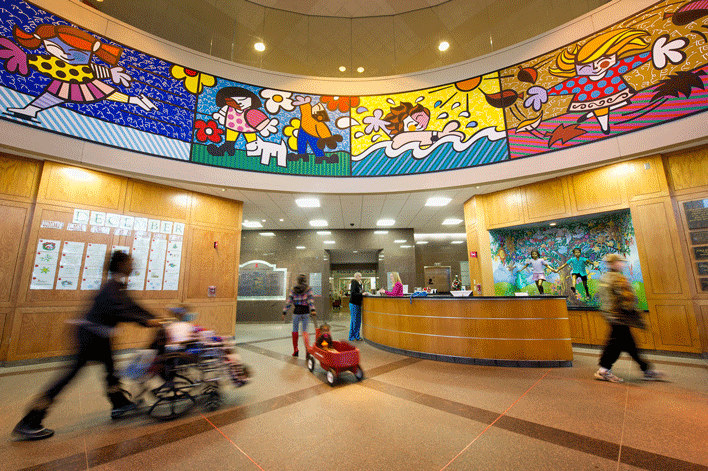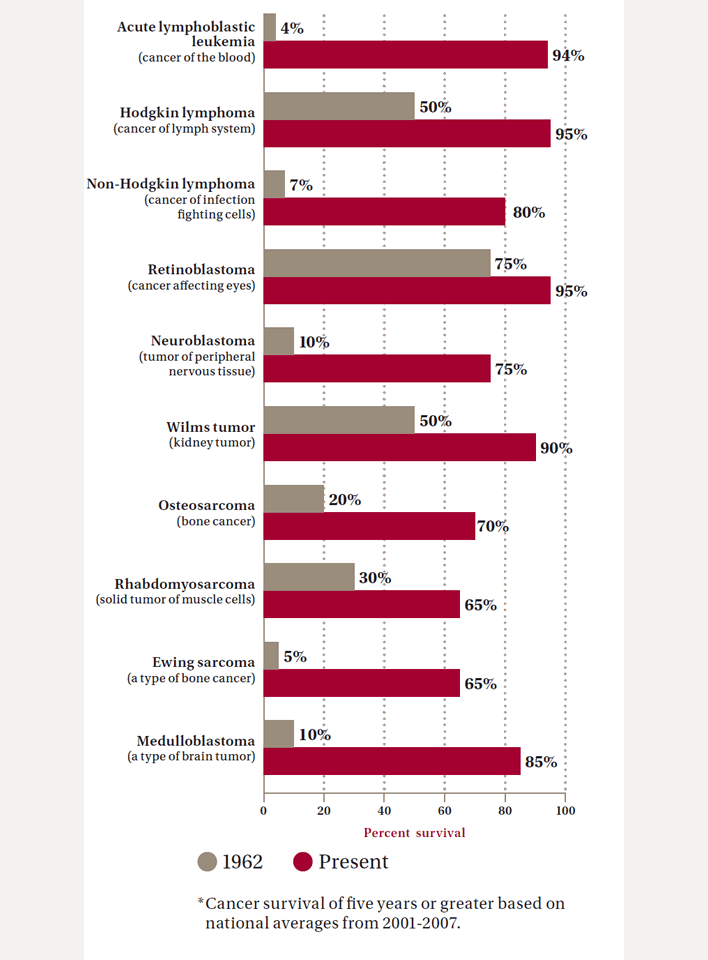what percent of donations go to st. jude
Most Americans have probably heard of St. Jude Children's Research Hospital. St. Jude fundraising letters arrive in mailboxes from coast to declension. Yet it's a safety guess that considerably fewer could say what it does. St. Jude is one of America'due south well-nigh remarkable healthcare charities. Since its founding 50 years ago, St. Jude has helped to push survival rates for catastrophic childhood cancers from twenty percent to about 80 percent—in a child-friendly temper and without charging families for treatment.
"I give to St. Jude for the simple fact that their sole commitment is the cure of all diseases afflicting children," says Tom Dunbar, an asset managing director in Louisville, Kentucky. Dunbar's son Evan was treated at St. Jude but died of neuroblastoma in 2001 at age half-dozen. "This commitment and their success accept saved and greatly improved the lives of millions of children and their families, simply they realize they have more to cure." He donates well-nigh $100,000 per twelvemonth to the hospital that once treated his ailing child.
The infirmary was conceived when a Lebanese-American actor entered a Catholic church in Detroit. He had a young family to support and was struggling to find work. "Aid me find my mode in life," he prayed to St. Jude Thaddeus, the patron saint of hopeless causes, "and I volition build you a shrine where the poor and the helpless and the hopeless may come up for comfort and assist."
The actor was Danny Thomas, and his star soon began to rising—he became a radio, Idiot box, and movie celebrity in the '40s and '50s. As his fame grew, he pursued his idea for a shrine to St. Jude. But he couldn't practice information technology alone, and then Thomas enlisted the help of people with like heritage. That effort became known in 1957 as the American Lebanese Syrian Associated Charities (ALSAC), which is the fundraising arm of St. Jude. Together, ALSAC and Thomas raised enough coin to open the hospital in 1962.

The hospital is at present America'south third-largest healthcare clemency and the 15th largest charity overall, according to the Chronicle of Philanthropy. ALSAC raises upward of $750 meg every year. Operating the infirmary costs most $1.vii million per day, and 81 cents of every dollar ALSAC collects goes toward research and handling. David McKee, ALSAC's principal operating officeholder, says that 74 percentage of St. Jude's upkeep comes from donations. (Most hospitals derive nigh viii–10 percent of their budgets from charitable giving.) "The residual of [our income] comes from insurance recovery and research grants," he explains.
One of Thomas' first priorities was to ensure no i would be turned away because of an inability to pay for services. "When I first thought nearly the hospital, I wanted in that location to be a dominion that no one would ever ask families about race, creed, color, or power to pay before their children could be admitted to St. Jude," Thomas in one case said. "I have no patience with hospitals that want a lot of numbers from people before they start treating them." That dominion is honored today. St. Jude collects what it tin from insurance, and no family unit is ever sent a neb for a child's care. St. Jude besides provides, at no charge, prescriptions, medical supplies, travel to and from Memphis, and family unit lodging while a patient is being treated.
All of the children treated at St. Jude—7,800 per year—are enrolled in a clinical research written report. St. Jude patients are therefore more probable to have rare diseases or cancers that are harder to treat. These investigations yield fresh treatments for once-deadly illnesses. The clinical studies done at St. Jude have helped to instigate the dramatic increases in babyhood cancer survival rates that accept taken identify in the U.Southward. over the last generation (come across graph beneath).
U.South. Survival Rates for Selected Childhood Cancers

The hospital's success rates aren't the merely matter that draws supporters. The cheerful and child-friendly environs, where walls are painted with brilliant colors, and bald toddlers race effectually on tricycles, is besides part of its appeal. St. Jude has "captured my heart and mind," says Mary Wardrop, a retired math professor from Monroe, Louisiana. "The loving, curative care of the children who come for help, and their families, is touching. The research that identifies the causes for the various illnesses, and the transition from that research to cures, is intellectually stimulating for me." Although she started giving pocket-sized amounts in 2000, Wardrop made her first serious donation—$50,000—in 2003. Since then, she has given a total of near $260,000, including three charitable annuities.
The average souvenir to St. Jude is near $30. The hospital's biggest fundraising vehicle by far is a direct-postal service pledge program called Partners in Hope. The next-largest fundraiser is the Danny Thomas Order, a planned giving program. Afterward that come more than 34,000 regional events and programs each yr, such as Upwards 'til Dawn on more than 300 college campuses nationwide and the Country Cares radiothon.
A more contempo addition to St. Jude'due south stable of fundraising vehicles is the almanac Thanks & Giving entrada begun in 2004 by Thomas' children, Marlo, Terre, and Tony Thomas. It raises millions for the hospital between Thanksgiving and New year's Day.
Equally St. Jude'due south founder once said, "I'd rather have a 1000000 people give me a dollar than 1 requite me a million. That way you lot've got a one thousand thousand people involved."
Lindsay Jones is a reporter for the Memphis Flyer and Memphis magazine.
Source: https://www.philanthropyroundtable.org/magazine/millions-from-millions/
0 Response to "what percent of donations go to st. jude"
Post a Comment